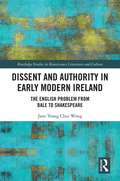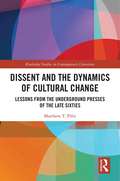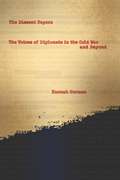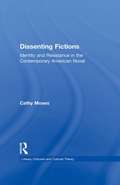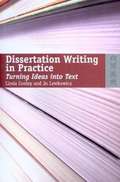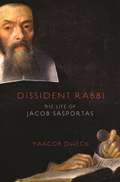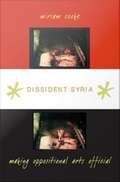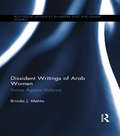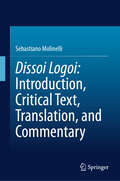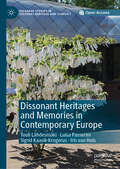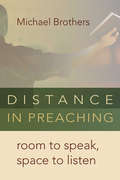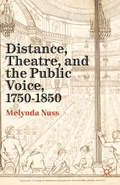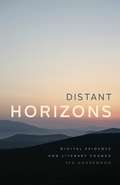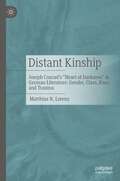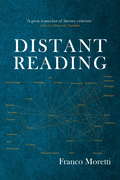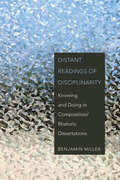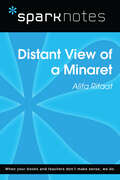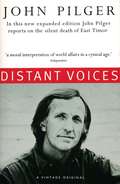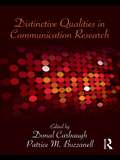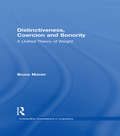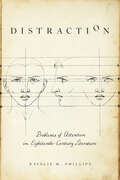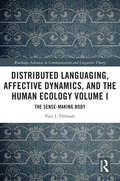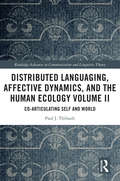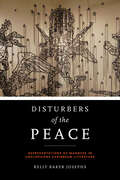- Table View
- List View
Dissent and Authority in Early Modern Ireland: The English Problem from Bale to Shakespeare (Routledge Studies in Renaissance Literature and Culture)
by Jane WongDissent and Authority in Early Modern Ireland: The English Problem from Bale to Shakespeare examines the problems that beset the Tudor administration of Ireland through a range of selected 16th century English narratives. This book is primarily concerned with the period between 1541 and 1603. This bracket provides a framework that charts early modern Irish history from the constitutional change of the island from lordship to kingdom to the end of the conquest in 1603. The mounting impetus to bring Ireland to a "complete" conquest during these years has, quite naturally, led critics to associate England’s reform strategies with Irish Otherness. The preoccupation with this discourse of difference is also perceived as the "Irish Problem," a blanket term broadly used to describe just about every aspect of Irishness incompatible with the English imperialist ideologies. The term stresses everything that is "wrong" with the Irish nation—Ireland was a problem to be resolved. This book takes a different approach towards the "Irish Problem." Instead of rehashing the English government’s complaints of the recalcitrant Irish and the long struggle to impose royal authority in Ireland, I posit that the "Irish Problem" was very much shaped and developed by a larger "English Problem," namely English dissent within the English government. The discussions in this book focuse on the ways in which English writers articulated their knowledge and anxieties of the "English Problem" in sixteenth-century literary and historical narratives. This book reappraises the limitations of the "Irish Problem," and argues that the crown’s failure to control dissent within its own ranks was as detrimental to the conquest as the "Irish Problem," if not more so, and finally, it attempts to demonstrate how dissent translate into governance and conquest in early modern Ireland.
Dissent and the Dynamics of Cultural Change: Lessons from the Underground Presses of the Late Sixties (Routledge Studies in Contemporary Literature)
by Matthew T. PiferDissent and the Dynamics of Cultural Change: Lessons from the Underground Presses of the Late Sixties, examines alternative presses’ critique of culture at a time of infamous transformation and revolution in the United States. In this new study, author Matthew Pifer seeks to delineate the structure of dissent to better understand how cultural change is realized, and explores the relationships between the public and those cultural institutions that define the values and social norms that shaped daily life.
The Dissent Papers: The Voices of Diplomats in the Cold War and Beyond
by Hannah GurmanBeginning with the Cold War and concluding with the 2003 invasion of Iraq, Hannah Gurman explores the overlooked opposition of U.S. diplomats to American foreign policy in the latter half of the twentieth century. During America's reign as a dominant world power, U.S. presidents and senior foreign policy officials largely ignored or rejected their diplomats' reports, memos, and telegrams, especially when they challenged key policies relating to the Cold War, China, and the wars in Vietnam and Iraq. The Dissent Papers recovers these diplomats' invaluable perspective and their commitment to the transformative power of diplomatic writing.Gurman showcases the work of diplomats whose opposition enjoyed some success. George Kennan, John Stewart Service, John Paton Davies, George Ball, and John Brady Kiesling all caught the attention of sitting presidents and policymakers, achieving temporary triumphs yet ultimately failing to change the status quo. Gurman follows the circulation of documents within the State Department, the National Security Council, the C.I.A., and the military, and she details the rationale behind "The Dissent Channel," instituted by the State Department in the 1970s, to both encourage and contain dissent. Advancing an alternative narrative of modern U.S. history, she connects the erosion of the diplomatic establishment and the weakening of the diplomatic writing tradition to larger political and ideological trends while, at the same time, foreshadowing the resurgent significance of diplomatic writing in the age of Wikileaks.
The Dissenters
by John L. GwaltneyOral histories of people who have engaged in acts of principled dissent collected by eminent, blind, African American anthropologist.
Dissenting Fictions: Identity and Resistance in the Contemporary American Novel (Literary Criticism and Cultural Theory)
by Cathy MosesFirst Published in 2000. Routledge is an imprint of Taylor & Francis, an informa company.
Dissertation Writing in Practice
by Linda Cooley Jo LewkowiczThis book is designed to raise students' awareness of the linguistic features of a postgraduate dissertation/thesis written in English. It deals primarily with the linguistic aspects of extended pieces of writing, placing great emphasis on the writer's responsibility for the readability of the text. Each of the features introduced is illustrated through examples taken from authentic writing at the appropriate level. In addition, each chapter has a number of tasks to help students put into practice the skills that have been introduced. This book is mainly designed to help research students whose first language is not English, but it should also prove useful to native speakers of English, many of whom lack extensive experience of writing at this level. It can be used as a textbook for postgraduate students on a dissertation/thesis writing course, and may also be used as a self-study guide since an annotated answer key is provided for all the tasks. This book takes a realistic approach to helping students who may find the extended writing required at postgraduate level a daunting task; although it provides ample opportunities for practice, it does not expect students to produce extensive writing beyond that required for their degree.
Dissident Rabbi: The Life of Jacob Sasportas
by Yaacob DweckIn 1665, Sabbetai Zevi, a self-proclaimed Messiah with a mass following throughout the Ottoman Empire and Europe, announced that the redemption of the world was at hand. As Jews everywhere rejected the traditional laws of Judaism in favor of new norms established by Sabbetai Zevi, and abandoned reason for the ecstasy of messianic enthusiasm, one man watched in horror. Dissident Rabbi tells the story of Jacob Sasportas, the Sephardic rabbi who alone challenged Sabbetai Zevi's improbable claims and warned his fellow Jews that their Messiah was not the answer to their prayers.Yaacob Dweck's absorbing and richly detailed biography brings to life the tumultuous century in which Sasportas lived, an age torn apart by war, migration, and famine. He describes the messianic frenzy that gripped the Jewish Diaspora, and Sasportas's attempts to make sense of a world that Sabbetai Zevi claimed was ending. As Jews danced in the streets, Sasportas compiled The Fading Flower of the Zevi, a meticulous and eloquent record of Sabbatianism as it happened. In 1666, barely a year after Sabbetai Zevi heralded the redemption, the Messiah converted to Islam at the behest of the Ottoman sultan, and Sasportas's book slipped into obscurity.Dissident Rabbi is the revelatory account of a spiritual leader who dared to articulate the value of rabbinic doubt in the face of messianic certainty, and a revealing examination of how his life and legacy were rediscovered and appropriated by later generations of Jewish thinkers.
Dissident Syria: Making Oppositional Arts Official
by Miriam CookeFrom 1970 until his death in 2000, Hafiz Asad ruled Syria with an iron fist. His regime controlled every aspect of daily life. Seeking to preempt popular unrest, Asad sometimes facilitated the expression of anti-government sentiment by appropriating the work of artists and writers, turning works of protest into official agitprop. Syrian dissidents were forced to negotiate between the desire to genuinely criticize the authoritarian regime, the risk to their own safety and security that such criticism would invite, and the fear that their work would be co-opted as government propaganda, as what miriam cooke calls "commissioned criticism. " In this intimate account of dissidence in Asad's Syria, cooke describes how intellectuals attempted to navigate between charges of complicity with the state and treason against it. A renowned scholar of Arab cultures, cooke spent six months in Syria during the mid-1990s familiarizing herself with the country's literary scene, particularly its women writers. While she was in Damascus, dissidents told her that to really understand life under Hafiz Asad, she had to speak with playwrights, filmmakers, and, above all, the authors of "prison literature. " She shares what she learned in Dissident Syria. She describes touring a sculptor's studio, looking at the artist's subversive work as well as at pieces commissioned by the government. She relates a playwright's view that theater is unique in its ability to stage protest through innuendo and gesture. Turning to film, she shares filmmakers' experiences of making movies that are praised abroad but rarely if ever screened at home. Filled with the voices of writers and artists, Dissident Syria reveals a community of conscience within Syria to those beyond its borders.
Dissident Writings of Arab Women: Voices Against Violence (Routledge Advances in Middle East and Islamic Studies)
by Brinda J. MehtaDissident Writings of Arab Women: Voices Against Violence analyzes the links between creative dissidence and inscriptions of violence in the writings of a selected group of postcolonial Arab women. The female authors destabilize essentialist framings of Arab identity through a series of reflective interrogations and "contesting" literary genres that include novels, short stories, poetry, docudramas, interviews and testimonials. Rejecting a purist "literature for literature’s sake" ethic, they embrace a dissident poetics of feminist critique and creative resistance as they engage in multiple and intergenerational border crossings in terms of geography, subject matter, language and transnationality. This book thus examines the ways in which the women’s writings provide the blueprint for social justice by "voicing" protest and stimulating critical thought, particularly in instances of social oppression, structural violence, and political transition. Providing an interdisciplinary approach which goes beyond narrow definitions of literature as aesthetic praxis to include literature’s added value as a social, historical, political, and cultural palimpsest, this book will be a useful resource for students and scholars of North African Studies, Postcolonial Studies, Francophone Studies, and Feminist Studies.
Dissoi Logoi: Introduction, Critical Text, Translation, and Commentary
by Sebastiano MolinelliThis new critical edition of Dissoi Logoi starts from a codicological analysis that is unprecedented in scope (the studied codices are twenty-six) and depth (their material, dimensions, transmitted works, provenance, date, scribe, first possessors, and current place of conservation are considered). On this basis, a new stemma codicum and a new Greek critical text with parallel English translation are offered. The extensive introduction reconstructs the manuscript and printed transmission of the text and sheds new light on its nature and its reception in antiquity. Dissoi Logoi appears to have been written between 355 and 338 BCE, in an Eastern form of Doric κοινή, by a sophist who aimed to promote his course. It likely worked as a source for Sextus Empiricus, which contributes to explaining the work’s collocation at the end of Sextus' codices. The third and final part of the book consists in a two-level commentary. First, the Structural Commentary looks into blocks of chapters from a rhetorical and philosophical perspective. Then, the Lemmatic Commentary delves into the most salient lemmas of the text, covering textual, linguistic, literary, and historical issues as well.
Dissonant Heritages and Memories in Contemporary Europe (Palgrave Studies in Cultural Heritage and Conflict)
by Tuuli Lähdesmäki Luisa Passerini Sigrid Kaasik-Krogerus Iris Van HuisThis open access book discusses political, economic, social, and humanitarian challenges that influence both how people deal with their past and how they build their identities in contemporary Europe. Ongoing debates on migration, on local, national, inter- and transnational levels, prove that it is a divisive issue with regards to understanding European integration and identity. At the same time, the European Union increasingly invests in projects related to European heritage, museums, and cultural memory networks, while having to take dissonant heritages into account. These processes in their combination offer an interesting dynamic and form the complex puzzle that poses challenging questions for anyone involved in academic research, heritage practices, and policy debates. With this puzzle at its core, this book explicitly focuses on slippery and transforming notions of Europe and critically discusses ongoing and transforming power structures of heritage and memory in today’s Europe. The book combines theoretical and methodological contributions to the debates on European heritage and memory studies and in-depth analyses of empirical case studies. Its main aim is to bring research fields concerning memory and heritage into a closer dialogue and thus explore the cultural and political dynamics of contemporary Europe.
Distance in Preaching: Room to Speak, Space to Listen
by Michael BrothersBased on several years of teaching and careful observation in preaching classes, this book by Michael Brothers explores the benefits of "distance" in preaching -- and listening to -- sermons.Having noticed that sermon listeners generally want to be given room for their own interpretations and experiences, Brothers argues that critical and aesthetic distance as a hermeneutical tool is vital to hearing the gospel today and should be intentionally employed in sermon construction and delivery. He explains this "distance" in the field of homiletics, equips teachers and students of preaching to evaluate the function of distance in sermons, and encourages preachers to practice the use of distance in their preaching.
Distance, Theatre, and the Public Voice, 1750–1850
by M. NussAs theatres expanded in the eighteenth and nineteenth centuries, the distance between actor and audience became a telling metaphor for the distance emerging between writers and readers. Nuss explores the ways in which theatre helped authors imagine connecting with a new mass audience.
Distant Horizons: Digital Evidence and Literary Change
by Ted UnderwoodJust as a traveler crossing a continent won’t sense the curvature of the earth, one lifetime of reading can’t grasp the largest patterns organizing literary history. This is the guiding premise behind Distant Horizons, which uses the scope of data newly available to us through digital libraries to tackle previously elusive questions about literature. Ted Underwood shows how digital archives and statistical tools, rather than reducing words to numbers (as is often feared), can deepen our understanding of issues that have always been central to humanistic inquiry. Without denying the usefulness of time-honored approaches like close reading, narratology, or genre studies, Underwood argues that we also need to read the larger arcs of literary change that have remained hidden from us by their sheer scale. Using both close and distant reading to trace the differentiation of genres, transformation of gender roles, and surprising persistence of aesthetic judgment, Underwood shows how digital methods can bring into focus the larger landscape of literary history and add to the beauty and complexity we value in literature.
Distant Kinship: Joseph Conrad's "Heart of Darkness" in German Literature: Gender, Class, Race, and Trauma
by Matthias N. LorenzThis study of Joseph Conrad's influential work "Heart of Darkness" presents for the first time the German-language reception of this reference text in the debate on postcolonialism. The spectrum ranges from Conrad's contemporaries (like Kafka) to many canonical authors of the 20th century (including Thomas Mann, Ernst Jünger, Christa Wolf) to the most recent names in literature (i.e. Christian Kracht und Lukas Bärfuss). Beyond the readings of their works, the study contributes to the study of cultural transfers as well as to Conrad philology, and it expands the theory of intertextuality with parameters that capture the complex factor of power in postcolonial relations.
Distant Reading
by Franco MorettiHow does a literary historian end up thinking in terms of z-scores, principal component analysis, and clustering coefficients? The essays in Distant Reading led to a new and often contested paradigm of literary analysis. In presenting them here Franco Moretti reconstructs his intellectual trajectory, the theoretical influences over his work, and explores the polemics that have often developed around his positions.From the evolutionary model of "Modern European Literature," through the geo-cultural insights of "Conjectures of World Literature" and "Planet Hollywood," to the quantitative findings of "Style, inc." and the abstract patterns of "Network Theory, Plot Analysis," the book follows two decades of conceptual development, organizing them around the metaphor of "distant reading," that has come to define--well beyond the wildest expectations of its author--a growing field of unorthodox literary studies.
Distant Readings of Disciplinarity: Knowing and Doing in Composition/Rhetoric Dissertations
by Benjamin MillerIn Distant Readings of Disciplinarity, Benjamin Miller brings a big data approach to the study of disciplinarity in rhetoric, composition, and writing studies (RCWS) by developing scalable maps of the methods and topics of several thousand RCWS dissertations from 2001 to 2015. Combining charts and figures with engaging and even playful prose, Miller offers an accessible model of how large-scale data-driven research can advance disciplinary understanding—both answering and amplifying the call to add replicable data analysis and visualization to the mix of methods regularly employed in the field. Writing studies has long been marked by a multitude of methods and interlocking purposes, partaking of not just humanities approaches but also social scientific ones, with data drawn from interviews and surveys alongside historical and philosophical arguments and with corpus analytics in large-scale collections jostling against small-scale case studies of individuals. These areas of study aren’t always cleanly separable; shifting modes mark the discipline as open and welcoming to many different angles of research. The field needs to embrace that vantage point and generate new degrees of familiarity with methods beyond those of any individual scholar. Not only a training genre and not only a knowledge-making genre, the dissertation is also a discipline-producing genre. Illustrating what the field has been studying, and how, Distant Readings of Disciplinarity supports more fruitful collaborations within and across research areas and methods.
Distant View of a Minaret (SparkNotes Literature Guide Series)
by SparkNotesDistant View of a Minaret (SparkNotes Literature Guide) by Alifa Rifaat Making the reading experience fun! Created by Harvard students for students everywhere, SparkNotes is a new breed of study guide: smarter, better, faster.Geared to what today's students need to know, SparkNotes provides:chapter-by-chapter analysis explanations of key themes, motifs, and symbols a review quiz and essay topics Lively and accessible, these guides are perfect for late-night studying and writing papers.
Distant Voices
by John PilgerThroughout his distinguished career as a journalist and film-maker, John Pilger has looked behind the 'official' versions of events to report the real stories of our time.The centrepiece of this new, expanded edition of his bestselling Distant Voices is Pilger's reporting from East Timor, which he entered secretly in 1993 and where a third of the population has died as a result of Indonesia's genocidal policies. This edition also contains more new material as well as all the original essays - from the myth-making of the Gulf War to the surreal pleasures of Disneyland. Breaking through the consensual silence, Pilger pays tribute to those dissenting voices we are seldom permitted to hear.
Distinctive Qualities in Communication Research
by Donal Carbaugh Patrice M. BuzzanellThis timely volume provides an in-depth look at why the field of communication is so central in initiatives for social impact around the world. In Distinctive Qualities in Communication Research, editors Donal Carbaugh and Patrice M. Buzzanell bring together scholars with varied and productive approaches to communication to address the question of what distinguishes communication research from similar studies in other disciplines. Each contributor responds to the question: "What makes your research communication research? How does your program of inquiry treat communication not simply as data, but as its primary theoretical concern?" Their responses are the heart of this book. The questions addressed and answered herein define the qualities that set research in communication apart from work in related fields, such as social psychology, linguistics, sociology, anthropology, and psychology. The book begins and ends by looking across these studies generally, bringing into view not only the specific possibilities in the study of communication today, but also what such study contributes generally to understanding human problems, social relations, and communities. This volume provides an invaluable resource for graduate students beginning their study in communication; academics needing to define the distinctive contributions that communication research makes; and administrators who want to understand the scope and breadth of work in communication. It provides an invaluable resource for defining the role of communication research in the academic community and the contributions it makes to the study of human interaction.
Distinctiveness, Coercion and Sonority: A Unified Theory of Weight (Outstanding Dissertations in Linguistics)
by Bruce MorenThis volume proposes a unified weight theory that challenges traditionally held beliefs regarding the vowel/consonant dichotomy inherent in moraicity and illuminates many previously intractable issues.
Distraction: Problems of Attention in Eighteenth-Century Literature
by Natalie M. PhillipsEnlightenment writers fiercely debated the nature of distraction in literature.Early novel reading typically conjures images of rapt readers in quiet rooms, but commentators at the time described reading as a fraught activity, one occurring amidst a distracting cacophony that included sloshing chamber pots and wailing street vendors. Auditory distractions were compounded by literary ones as falling paper costs led to an explosion of print material, forcing prose fiction to compete with a dizzying array of essays, poems, sermons, and histories. In Distraction, Natalie M. Phillips argues that prominent Enlightenment authors—from Jane Austen and William Godwin to Eliza Haywood and Samuel Johnson—were deeply engaged with debates about the wandering mind, even if they were not equally concerned about the problem of distractibility.Phillips explains that some novelists in the 1700s—viewing distraction as a dangerous wandering from singular attention that could lead to sin or even madness—attempted to reform diverted readers. Johnson and Haywood, for example, worried that contemporary readers would only focus long enough to "look into the first pages" of essays and novels; Austen offered wry commentary on the issue through the creation of the daft Lydia Bennet, a character with an attention span so short she could listen only "half-a-minute." Other authors radically redefined distraction as an excellent quality of mind, aligning the multiplicity of divided focus with the spontaneous creation of new thought. Laurence Sterne’s Tristram Shandy, for example, won audiences with its comically distracted narrator and uniquely digressive form.Using cognitive science as a framework to explore the intertwined history of mental states, philosophy, science, and literary forms, Phillips explains how arguments about the diverted mind made their way into the century’s most celebrated literature. She also draws a direct link between the disparate theories of focus articulated in eighteenth-century literature and modern experiments in neuroscience, revealing that contemporary questions surrounding short attention spans are grounded in long conversations over the nature and limits of focus.
Distributed Languaging, Affective Dynamics, and the Human Ecology Volume I: The Sense-making Body (Routledge Advances in Communication and Linguistic Theory)
by Paul J. ThibaultLanguage plays a central role in human life. However, the term ‘language’ as defined in the language sciences of the 20th century and the traditions these have drawn on, have arguably, limited our thinking about what language is and does. The two inter-linked volumes of Thibault’s study articulate crucially important aspects of an emerging new perspective shift on language - the Distributed Language view – that is now receiving more and more attention internationally. Rejecting the classical view that the fundamental architecture of language can be localized as a number of inter-related levels of formal linguistic organization that function as the coded inputs and outputs to each other, the distributed language view argues that languaging behaviour is a bio-cultural organisation of process that is embodied, multimodal, and integrated across multiple space-time scales. Thibault argues that we need to think of human languaging as the distinctively human mode of our becoming and being selves in the extended human ecology and the kinds of experiencing that this makes possible. Paradoxically, this also means thinking about language in non-linguistic ways that break the grip of the conventional meta-languages for thinking about human languaging. Thibault’s book grounds languaging in process theory: languaging and the forms of experience it actualizes is always an event, not a thing that we ‘use’. In taking a distinctively interdisciplinary approach, the book relates dialogical theories of human sense-making to the distributed view of human cognition, to recent thinking about distributed language, to ecological psychology, and to languaging as inter-individual affective dynamics grounded in the subjective lives of selves. In taking this approach, the book considers the coordination of selves in social encounters, the emergent forms of self-reflexivity that characterise these encounters, and the implications for how we think of and live our human sociality, not as something that is mediated by over-arching codes and systems, but as emerging from the endogenous subjectivities of selves when they seek to coordinate with other selves and with the situations, artefacts, social institutions, and technologies that populate the extended human ecology. The two volumes aim to bring our understanding of human languaging closer to human embodiment, experience, and feeling while also showing how languaging enables humans to transcend local circumstances and thus to dialogue with cultural tradition. Volume 1 focuses on the shorter timescales of bodily dynamics in languaging activity. Volume II integrates the shorter timescales of body dynamics to the longer cultural-historical timescales of the linguistic and cultural norms and patterns to which bodily dynamics are integrated.
Distributed Languaging, Affective Dynamics, and the Human Ecology Volume II: Co-articulating Self and World (Routledge Advances in Communication and Linguistic Theory)
by Paul J. ThibaultLanguage plays a central role in human life. However, the term "language" as defined in the language sciences of the 20th century and the traditions these have drawn on, have arguably limited our thinking about what language is and does. The two inter-linked volumes of Thibault’s study articulate crucially important aspects of an emerging new perspective shift on language—the Distributed Language view—that is now receiving more and more attention internationally. Rejecting the classical view that the fundamental architecture of language can be localised as a number of inter-related levels of formal linguistic organisation that function as the coded inputs and outputs to each other, the distributed language view argues that languaging behaviour is a bio-cultural organiation of process that is embodied, multimodal, and integrated across multiple space-time scales. Thibault argues that we need to think of human languaging as the distinctively human mode of our becoming and being selves in the extended human ecology and the kinds of experiencing that this makes possible. Paradoxically, this also means thinking about language in non-linguistic ways that break the grip of the conventional meta-languages for thinking about human languaging. Thibault’s book grounds languaging in process theory: languaging and the forms of experience it actualises is always an event, not a thing that we "use". In taking a distinctively interdisciplinary approach, the book relates dialogical theories of human sense-making to the distributed view of human cognition, to recent thinking about distributed language, to ecological psychology, and to languaging as inter-individual affective dynamics grounded in the subjective lives of selves. In taking this approach, the book considers the coordination of selves in social encounters, the emergent forms of self-reflexivity that characterise these encounters, and the implications for how we think of and live our human sociality, not as something that is mediated by over-arching codes and systems, but as emerging from the endogenous subjectivities of selves when they seek to coordinate with other selves and with the situations, artefacts, social institutions, and technologies that populate the extended human ecology. The two volumes aim to bring our understanding of human languaging closer to human embodiment, experience, and feeling while also showing how languaging enables humans to transcend local circumstances and thus to dialogue with cultural tradition. Volume I focuses on the shorter timescales of bodily dynamics in languaging activity. Volume II integrates the shorter timescales of body dynamics to the longer cultural–historical timescales of the linguistic and cultural norms and patterns to which bodily dynamics are integrated.
Disturbers of the Peace: Representations of Madness in Anglophone Caribbean Literature (New World Studies)
by Kelly Baker JosephsExploring the prevalence of madness in Caribbean texts written in English in the mid-twentieth century, Kelly Baker Josephs focuses on celebrated writers such as Jean Rhys, V. S. Naipaul, and Derek Walcott as well as on understudied writers such as Sylvia Wynter and Erna Brodber. Because mad figures appear frequently in Caribbean literature from French, Spanish, and English traditions—in roles ranging from bit parts to first-person narrators—the author regards madness as a part of the West Indian literary aesthetic. The relatively condensed decolonization of the anglophone islands during the 1960s and 1970s, she argues, makes literature written in English during this time especially rich for an examination of the function of madness in literary critiques of colonialism and in the Caribbean project of nation-making. In drawing connections between madness and literature, gender, and religion, this book speaks not only to the field of Caribbean studies but also to colonial and postcolonial literature in general. The volume closes with a study of twenty-first-century literature of the Caribbean diaspora, demonstrating that Caribbean writers still turn to representations of madness to depict their changing worlds.
